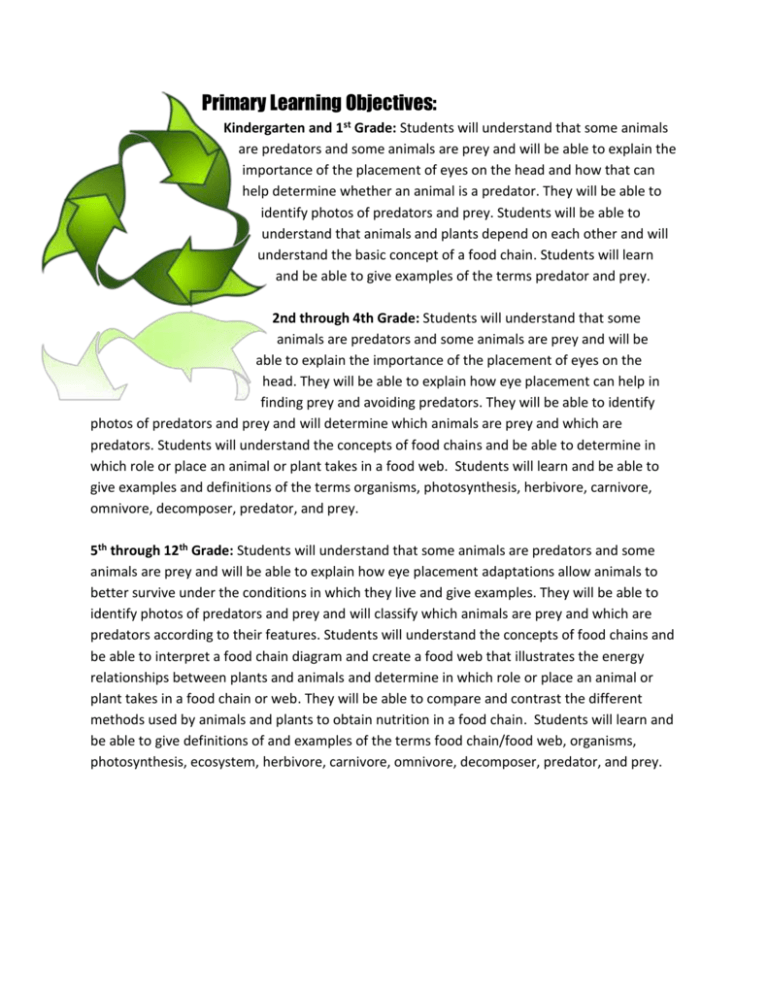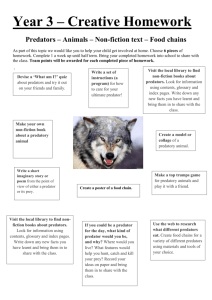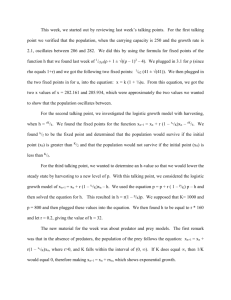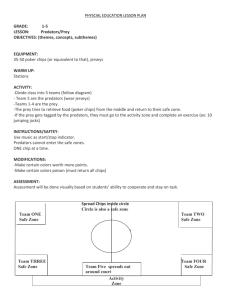The Eyes Have It- Predator and Prey
advertisement

Primary Learning Objectives: Kindergarten and 1st Grade: Students will understand that some animals are predators and some animals are prey and will be able to explain the importance of the placement of eyes on the head and how that can help determine whether an animal is a predator. They will be able to identify photos of predators and prey. Students will be able to understand that animals and plants depend on each other and will understand the basic concept of a food chain. Students will learn and be able to give examples of the terms predator and prey. 2nd through 4th Grade: Students will understand that some animals are predators and some animals are prey and will be able to explain the importance of the placement of eyes on the head. They will be able to explain how eye placement can help in finding prey and avoiding predators. They will be able to identify photos of predators and prey and will determine which animals are prey and which are predators. Students will understand the concepts of food chains and be able to determine in which role or place an animal or plant takes in a food web. Students will learn and be able to give examples and definitions of the terms organisms, photosynthesis, herbivore, carnivore, omnivore, decomposer, predator, and prey. 5th through 12th Grade: Students will understand that some animals are predators and some animals are prey and will be able to explain how eye placement adaptations allow animals to better survive under the conditions in which they live and give examples. They will be able to identify photos of predators and prey and will classify which animals are prey and which are predators according to their features. Students will understand the concepts of food chains and be able to interpret a food chain diagram and create a food web that illustrates the energy relationships between plants and animals and determine in which role or place an animal or plant takes in a food chain or web. They will be able to compare and contrast the different methods used by animals and plants to obtain nutrition in a food chain. Students will learn and be able to give definitions of and examples of the terms food chain/food web, organisms, photosynthesis, ecosystem, herbivore, carnivore, omnivore, decomposer, predator, and prey. Examples of Possible Standards to Incorporate: Use the standards to guide you in your approach and focus on a lesson, and any extensions you want to add to a lesson. Read through the lesson and then the standards with the lesson in mind, and use them as a guideline during your preparation and planning. Kindergarten: 7.3.1 Observe plants and animals and make recordings of their similarities and differences 1st Grade: 7.2.2. Record information about living or non-living materials (animals) based on their characteristics 2nd Grade: 7.2.2 Investigate ways that plants and animals depend on each other 3rd Grade: 7.3.1 Label a diagram to illustrate the food relationships that exist between plant and animals. 4th Grade: 7.3.2 Classify organisms as carnivores, herbivores, or omnivores 5th Grade: 7.3.2 Create a food web that illustrates the energy relationships between plants and animals and the key issues or assumptions found in the model. 6th Grade: 7.2.1 Compare and contrast the different methods used by organisms to obtain nutrition in a biological community. 7th Grade: 7.3.3 Identify the materials used by plants to make food. 8th Grade: 8.5.2 Classify plants and animals into groups according to their features. 9th Grade: CLE 3210.3.1 Analyze energy flow through an ecosystem. 10th Grade: SPI 3210.3.1 Interpret a diagram that illustrates energy flow in an ecosystem. 11th Grade: SPI 3210.5.1 Compare and contrast the structural, functional, and behavioral adaptations of animals or plants found in different environments. 12th Grade: CLE 3210.5.1 Associate structural, functional, and behavioral adaptations with the ability of organisms to survive under various environmental conditions. Remember, at least one ESL standard and one core curriculum standard for each grade level you are going to be working with must be incorporated into your lesson. For non-ESL students it will be two core-curriculum standards. Academic Vocabulary You do not have to use every word that is listed below, but choose one to two words for each grade level and make sure they are used and explained during your lesson. The words you choose to incorporate must be included in your daily reports. Kindergarten: senses, shape, follow/give directions, above, behind, below, beside, in front, inside, shape, size, human, animal features, food, insect 1st Grade: create, describe, illustrate, predict, reality, prediction, needs, balance, environment, location, ocean 2nd Grade: conversation, group discussion, everyday language, mental image, purpose, second, model, difference, characteristics, movement, individual differences, observation, properties, similarities and differences, behavior pattern, 3rd Grade: fact, opinion, organization, observe, physical properties, energy, organism, predator, prey, rotation 4th Grade: threatened, traits/characteristics, compare/contrast, attributes, cause/effect, drawing conclusions, thriving, reptiles, mammals, amphibians, adaptations, species, ecosystem 5th Grade: diameter, faces, comparative, consumer, decomposer, food web, forms of energy, energy transformations 6th Grade: common feature, properties, stress, evaluate, consumer, decomposer, food web, forms of energy, energy transformations, 7th Grade: clarify, image, organ, organ system, element 8th Grade: logic, exterior, interior, dilation, speed, common sense All living organisms in an ecosystem are dependent on one another. (Ask students what they think this means) To understand this relationship better we can show how energy flows from one organism to another by following a "food chain" or energy cycle. (Ask students what a chain is and then have them give their ideas on what a food chain could be. Why would it be called that? All the animals are “linked” together in one long chain.) Any food chain begins with the Sun and the energy it provides for growing plants. Plants are the first group of organisms in our food chain. Many insects, birds, and mammals depend on plants for their food. Animals that eat plants are called herbivores and make up the next group of organisms in the food chain. (Ask students to provide examples) Examples are grasshoppers, kangaroo mice, deer, pronghorns, and sparrows. Herbivores provide food for the next group...meat-eating animals we call carnivores. (Ask students to provide examples) Mountain lions, bobcats, snakes, and hawks are carnivores. The next group, omnivores, eats both plants and meat. (Ask students to provide examples) Bears, coyotes, and most people eat both plants and meat and are omnivorous. When any organism dies it provides food for the decomposers. (Ask students to provide examples) Bacteria, fungi, and earthworms are examples of decomposers. Many decomposers live in the air and soil and return dead material back to the soil where it is used by the plants. Predators are animals (or plants) that eat other animals. Prey are animals eaten by predators. It is better to use the word "predator" rather than "enemy". Enemy implies the emotion of hatred or doing something wrong. Predators play an important role in the energy cycle. Summary: All plants and animals in an area are dependent on one another and are “linked” together in one long chain according to what animal eats what. Some animals eat plants, those are herbivores. Some animals eat only other animals, those are carnivores. Some animals eat both plants and meat, those are called omnivores. Some animals eat only dead things, those are called decomposers. When an animal eats another animal, it is called a predator. The animal that got eaten is called prey. All of these animals and plants are important because without one of them all the other animals and plants couldn’t survive as well. Characteristics of Predator and Prey The eyes of predators face forward. These animals have good depth perception which means they can see how close or far away an animal is. Chasing and catching prey requires good vision in the direction one is moving...forward. Forward facing eyes can also focus on a single forward point. The eyes of prey animals are located along the side of the head. They have good side and rear vision. If an animal spends most of its time eating grass and leaves, being able to see to the side and rear without moving the head allows it to look out for predators and eat at the same time. Prey animals have almost 360-degree vision. (Ask students what that means. They can see all the way around their heads.) Ask the students to look at one another and decide if humans have predator or prey eyes. Cut the predators and prey animals into sheets and have the students identify which animal belongs to what category. Summary: Eyes are important and where they are on the animal’s head is important too. Predators have eyes that face forward, which helps them hunt their prey and keep them in sight if they have to chase them. Prey have eyes on the sides of their heads, this helps them see if a predator is coming because they can look behind them without moving their heads. Writing Activity: Have students draw a picture of a new kind of animal. Is their animal a predator or a prey animal? What kind of eyes does it have? How does it see the world? Does it sleep all day or at night? What would it need to be fed? Have the students write a description of their animal for a zoo. Food Chains http://www.sheppardsoftware.com/content/animals/kidscorner/foodchain/foodchain.htm Every living thing needs energy in order to live. Every time animals do something (run, jump) they use energy to do so. Animals get energy from the food they eat, and all living things get energy from food. Plants use sunlight, water and nutrients to get energy (in a process called photosynthesis). Energy is necessary for living beings to grow. A food chain shows how each living thing gets food, and how nutrients and energy are passed from creature to creature. Food chains begin with the sun helping plant-life to grow, and end with animal-life. Some animals eat plants, some animals eat other animals. A simple food chain could start with grass, which is eaten by rabbits. Then the rabbits are eaten by foxes. Here's a food chain, with a few more animals. It starts with acorns, which are eaten by mice. The mice are eaten by snakes, and then finally the snakes are eaten by hawks. At each link in the chain, energy is being transferred from one animal to another. There can be even more links to any food chain. Here another animal is added. It goes grass to grasshopper to mouse to snake to hawk There is actually even more to this chain. After a hawk dies, fungi (like mushrooms) and other decomposers break down the dead hawk, and turn the remains of the hawk into nutrients, which are released into the soil. The nutrients (plus sun and water) then cause the grass to grow. It's a full circle of life and energy!! So food chains make a full circle, and energy is passed from plant to animal to animal to decomposer and back to plant! There can be many links in food chains but not TOO many. If there are too many links, then the animal at the end would not get enough energy. Summary: Every living thing needs energy in order to live. Every time animals do something (run, jump) they use energy and need to get more. Animals get energy from the food they eat, and all living things get energy from food. A food chain shows how each living thing gets food, and how energy is passed from creature to creature. Food chains begin with the sun helping plants to grow, and end with animals. Some animals eat plants, some animals eat other animals, but they are all connected together by who eats what. Food chains eventually make a full circle, and energy is passed from plant to animal to animal to decomposer and back to plant! Cut the parts out of the following sheets and have them put the food chains in order and explain why they made the choices they did and why each part belongs where it is. Can they tell you any other food chains? Quick, what’s the difference between your eyes and the eyes of a gecko? A cat? An owl? A kangaroo? For centuries, humans were in the dark about what and how other animals see. There was no way to know what the world looked like to different animals because it was so hard to determine whether an animal could see a particular color. But new testing methods are making it possible to find the answers. A strong incentive for some of the animal research is that it may lead to a better understanding of how we see. Recent scientific investigation has revealed an amazing world of how differently animals see. Like the dragonfly – its brain works so fast that it sees all movements in slow motion. Or the pigeon – which is capable of detecting more colors than the most advanced computer. Or the snake – there is no escaping heat vision (heat vision lets snakes see things by detecting temperatures, like the picture on the left). Read on to learn how very different eyes can be and determine which of the following animals are predators and which are prey. Can an animal be both? (Show students the pictures of the following animal’s eyes as you discuss them) Some geckos have eyes with pupils shaped like slits. Ask students why they think they aren’t they round, like the pupils in your eyes? These lizards hunt at night, so they have good night vision. If they had round pupils, bright sunlight during the day would overwhelm their eyes, which are very sensitive to light. In bright light, the gecko’s iris squeezes shut so the pupil looks as narrow as the hands of a clock at 6:00 p.m. Cats also have good night vision. In bright light, a cat’s pupil shuts down to a slit. And like some other animals (including dogs, cows, and sheep), cats have a tapetum, a layer of light-reflective cells that lines their eyes. Light bouncing off this reflective layer makes your cat’s eyes shine in the dark. Owls hunt at night, too, and they have very large eyes to help them see well in the dark. But unlike our eyes, an owl’s eyes are fixed in place, staring straight ahead. To look in a different direction, an owl must turn its head. Owls are so good at this they can turn their heads to look behind them. Goats, kangaroos, and antelope have rectangular pupils that are horizontal to the ground. These animals keep a sharp eye out for predators, and rectangular pupils let them watch over a large area. Crabs have eyes on stalks that stick up above their head, letting them look in many different directions without turning around. Animals such as rabbits and deer have eyes on the sides of their head, with very little overlap in each eye’s visual field. This kind of vision, called “all-around vision,” lets them scan large areas both to the right and the left, which helps them quickly spot predators. Horses (Image via nosha) Horses have an amazing range of vision – that is, except for what is right in front of them. They literally can’t spot whatever is between their eyes and therefore directly ahead due to their binocular vision. This is why they so often look down as they walk. Birds Many birds can see differently. They have many more cones than humans in their eyes. (Ask the students what cones help us see.) Pigeons, for example, can see literally millions of different colors and are thought to be among the best at color detection ability of any animal on earth. Rabbit Eye image from: www.pbase.com/leelooita/image/68846521 Owl image from: http://farm3.static.flickr.com/2184/2114302589_3644e48b27.jpg Image from www.showcatsonline.com/.../eye_glasses.jpg If your students have ever wondered how different animals see their world, these easy-to-make viewers help your students change their vision and get an owl (or a mouse or a cat) – eye view on the world. Materials: Toilet paper cardboard tubes or 2 pieces of cardstock made into tubes Drinking Straws Tape Cardboard egg carton Pencil Scissors Bandana How Owls See Staple two toilet paper tubes together. Look through the tubes. They’ll notice that they can only look straight ahead. To see what is beside them, they’ll need to turn their head. Owls don’t have round eyeballs, instead they are cylindrical – or shaped a bit like the tubes them are looking through. Cylindrical eyeballs can’t roll in their sockets. Instead, the only way an owl can move its eyes is by moving its entire head. It’s a good thing, then, that owls have flexible necks so they can look around and find their prey. Bug Eye Viewer Take a handful of approximately twenty-five straight drinking straws and cut them in half. Hold half of the straws in a bunch and wrap masking tape around the bundle (they may need help with this). Add a second piece of tape at the other end of the straws. Tape the other bundle of straws together. Next, tape these two bunches of straws together and look through the viewer. Unlike how insect eye toys work, an insect doesn’t see duplications of the same scene. Instead, it sees one scene broken into many separate sections. Seeing Underground Like a Mole Cut two attached sections from a cardboard egg carton. Set the sections on a table and poke a sharp pencil into the center of both bottom pieces so the pencil tip just pierces the cardboard. Clear away the bit of cardboard created by the hole. Hold this viewer up to their eyes. They will only be able to see a small point in front of them. Because moles spend most of their lives in dark tunnels, they don’t need large eyes. Mouse Vision Follow the same procedure for the mole eye activity only poke the entire pencil into the bottom of the egg carton to make the hole larger. With scissors, carefully cut the opening larger so they remove the bottom of the egg carton. Hold this viewer up to their eyes. Unlike the mole eye viewer with its small eye openings, these holes are much larger, just like a mouse’s eyes. Mice have large eyes, which allow them to see food and predators in dim light. Cat Eye Activity Create a pirate patch out of paper and tape on a piece of yarn so them can tie the patch around their head or use a bandana. Them want to make certain that the piece of paper or bandana covers their eye socket and blocks light from their eye. Now, wear the patch over their closed eye for fifteen or twenty minutes in daylight or a room with bright lights. Find a nearly dark room and close the door. Remove the pirate patch. Open the eye that was covered and close the eye that had been open. Next, switch opened and closed eyes. The covered eye has night vision so the room will seem brighter. Because that eye has been in the dark, the pupil is open wider, allowing in more light. Nocturnal animals’ eyes are able to capture more light than their eyes normally can, which helps them to see in the dark.









